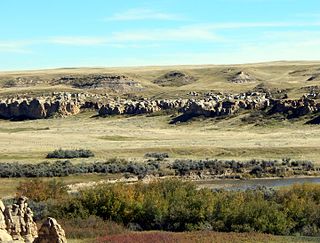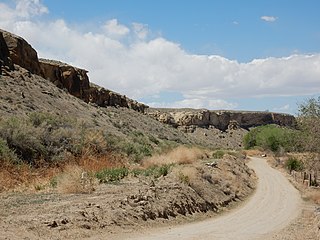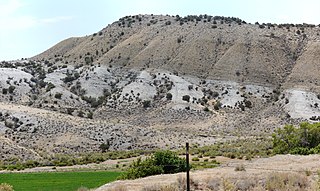| Cokedale Formation | |
|---|---|
| Stratigraphic range: Campanian | |
| Type | Geological formation |
| Unit of | Livingston Group |
| Underlies | Miner Creek Formation |
The Cokedale Formation is a Mesozoic geologic formation in the United States. Dinosaur remains are among the fossils that have been recovered from the formation, although none have yet been referred to a specific genus. [1]
The Cokedale Formation is the oldest unit of the Livingston Group. [2]

The Scollard Formation is an Upper Cretaceous to lower Palaeocene stratigraphic unit of the Western Canada Sedimentary Basin in southwestern Alberta. Its deposition spanned the time interval from latest Cretaceous to early Paleocene, and it includes sediments that were deposited before, during, and after the Cretaceous-Paleogene (K-Pg) extinction event. It is significant for its fossil record, and it includes the economically important coal deposits of the Ardley coal zone.

The Cloverly Formation is a geological formation of Early and Late Cretaceous age that is present in parts of Montana, Wyoming, Colorado and Utah in the western United States. It was named for a post office on the eastern side of the Bighorn Basin in Wyoming by N.H. Darton in 1904. The sedimentary rocks of formation were deposited in floodplain environments and contain vertebrate fossils, including a diverse assemblage of dinosaur remains. In 1973, the Cloverly Formation Site was designated as a National Natural Landmark by the National Park Service.
The Belly River Group is a stratigraphical unit of Late Cretaceous age in the Western Canadian Sedimentary Basin.

The Foremost Formation is a stratigraphic unit of Late Cretaceous (Campanian) age that underlies much of southern Alberta, Canada. It was named for outcrops in Chin Coulee near the town of Foremost and is known primarily for its dinosaur remains and other fossils.

The Eagle Sandstone, originally the Eagle Formation, is a geological formation in Montana whose strata date back to the Late Cretaceous. It is a light to brownish gray to pale yellow-orange, fine-grained sandstone. It contains areas of crossbedding and local shale members. It contains large sandy calcareous concretions. Its thickness varies from 100 to 350 feet due to the lens nature of the individual sandstone layers and local interbedded sandy shale layers.
The Claggett Shale is a geological formation in Montana whose strata date back to the Late Cretaceous. Dinosaur remains are among the fossils that have been recovered from the formation.
The Livingston Group is a geological formation in Montana whose strata date back to the Late Cretaceous. Dinosaur remains are among the fossils that have been recovered from the formation.

The Frontier Formation is a sedimentary geological formation whose strata date back to the Late Cretaceous. The formation's extents are: northwest Colorado, southeast Idaho, southern Montana, northern Utah, and western Wyoming. It occurs in many sedimentary basins and uplifted areas.

The Arapahoe Formation is a geological formation of latest Cretaceous (Maastrichtian) age that is present within the Denver Basin that underlies the Denver, Colorado, area. The formation includes fossil leaves and dinosaur remains, although none of the latter have yet been referred to a specific genus. It also includes aquifers that are important sources of water for the area.
The Bahia Group, also known as Bahia Series, is an Aptian geologic group of the Recôncavo Basin in Bahia, Brazil. Dinosaur remains are among the fossils that have been recovered from the formation, although none have yet been referred to a specific genus. The conglomerates were deposited in an estuarine environment.
The Billman Creek Formation is a Mesozoic geologic formation in south-central Montana. Dinosaur remains are among the fossils that have been recovered from the formation, although none have yet been referred to a specific genus.
The Horsethief Sandstone is a Mesozoic geologic formation in Montana. Dinosaur remains are among the fossils that have been recovered from the formation, although none have yet been referred to a specific genus. The southern part of the Two Medicine Formation grades into the brackish water siltstone/sandstone series that compose the Horsethief Formation. To the north the Horsethief Sandstone is equivalent to the Blood Reserve Formation of Alberta, Canada.
The Iljig Formation is a Lower Cretaceous geologic formation in South Korea. Dinosaur remains are among the fossils that have been recovered from the formation, although none have yet been referred to a specific genus.
The Kootenai Formation is a Lower Cretaceous geologic formation. The Kootenai was deposited in a foreland basin east of the Sevier thrust belt in western Montana. The lithology consists of a basal conglomerate with overlying non-marine sandstones, shales and lacustrine limestones.

The Moenave Formation is a Mesozoic geologic formation, in the Glen Canyon Group. It is found in Utah and Arizona.

The Pictured Cliffs Formation is a Campanian geologic formation in the San Juan Basin of New Mexico. Dinosaur remains are among the fossils that have been recovered from the formation, although none have yet been referred to a specific genus.
The Telegraph Creek Formation is a Mesozoic geologic formation in Montana, United States. Dinosaur remains are among the fossils that have been recovered from the formation, although none have yet been referred to a specific genus.

The Mowry Shale is an Early Cretaceous geologic formation. The formation was named for Mowrie Creek, northwest of Buffalo in Johnson County, Wyoming.
The Zhenzhuchong Formation is an Early Jurassic geologic formation in China. Plesiosaur remains are among the fossils that have been recovered from its strata. Remains of the prosauropod Lufengosaurus huenei have been recovered from this formation As well as dinosaur footprints.
The Lossiemouth Sandstone is a Middle to Late Triassic age geological formation. It is exposed on the south side of the Moray Firth near Lossiemouth and near Golspie in Sutherland. Dinosaur remains are among the fossils that have been recovered from the formation.